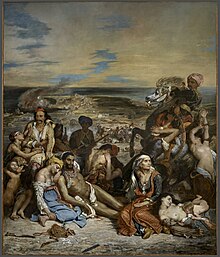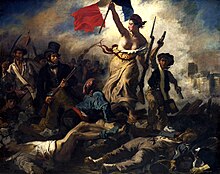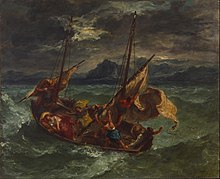Liberty Leading the People (1830), Louvre
Liberty Leading the People (1830), Louvre
"Η Ελευθερία οδηγεί τον λαό" (1830), πίνακας του Eugene Delacroix.
Πιστεύεται ότι η Théroigne ενέπνευσε στον Delacroixτη γυναικεία μορφή
της Ελευθερίας.
Eugène Delacroix
From Wikipedia, the free encyclopedia
Ferdinand Victor Eugène Delacroix (26 April 1798 – 13 August 1863)
Eugène Delacroix
| Eugène Delacroix | |
|---|---|

Eugène Delacroix (portrait by Nadar)
|
|
| Born | Ferdinand Victor Eugène Delacroix 26 April 1798 Charenton-Saint-Maurice, Île-de-France, France |
| Died | 13 August 1863 (aged 65) Paris, France |
| Nationality | French |
| Known for | Painting, Lithography |
| Notable work | Liberty Leading the People, 1830 |
| Movement | Romanticism |
As a painter and muralist, Delacroix's use of expressive brushstrokes and his study of the optical effects of colour profoundly shaped the work of the Impressionists, while his passion for the exotic inspired the artists of the Symbolist movement. A fine lithographer, Delacroix illustrated various works of William Shakespeare, the Scottish author Walter Scott and the German author Johann Wolfgang von Goethe.
In contrast to the Neoclassical perfectionism of his chief rival Ingres, Delacroix took for his inspiration the art of Rubens and painters of the Venetian Renaissance, with an attendant emphasis on colour and movement rather than clarity of outline and carefully modelled form. Dramatic and romantic content characterized the central themes of his maturity, and led him not to the classical models of Greek and Roman art, but to travel in North Africa, in search of the exotic.[2] Friend and spiritual heir to Théodore Géricault, Delacroix was also inspired by Lord Byron, with whom he shared a strong identification with the "forces of the sublime", of nature in often violent action.[3]
However, Delacroix was given to neither sentimentality nor bombast, and his Romanticism was that of an individualist. In the words of Baudelaire, "Delacroix was passionately in love with passion, but coldly determined to express passion as clearly as possible."[4]
Contents
Early life
Portrait of Delacroix early in his career
There is reason to believe that Eugène's father, Charles-François Delacroix, was infertile at the time of Eugène's conception and that his real father was Talleyrand, who was a friend of the family and successor of Charles Delacroix as Minister of Foreign Affairs, and whom the adult Eugène resembled in appearance and character.[6] Throughout his career as a painter, he was protected by Talleyrand, who served successively the Restoration and king Louis-Philippe, and ultimately as ambassador of France in Great Britain, and later by Talleyrand's grandson, Charles Auguste Louis Joseph, duc de Morny, half-brother of Napoleon III and speaker of the French House of Commons. His presumed father, Charles Delacroix, died in 1805, and his mother in 1814, leaving 16-year-old Eugène an orphan.
His early education was at the Lycée Louis-le-Grand, and at the Lycée Pierre Corneille in Rouen[7] where he steeped himself in the classics and won awards for drawing. In 1815 he began his training with Pierre-Narcisse Guérin in the neoclassical style of Jacques-Louis David. An early church commission, The Virgin of the Harvest (1819), displays a Raphael-esque influence, but another such commission, The Virgin of the Sacred Heart (1821), evidences a freer interpretation.[8] It precedes the influence of the more colourful and rich style of the Flemish painter Peter Paul Rubens (1577–1640), and fellow French artist Théodore Géricault (1791–1824), whose works marked an introduction to Romanticism in art.
The impact of Géricault's The Raft of the Medusa was profound, and stimulated Delacroix to produce his first major painting, The Barque of Dante, which was accepted by the Paris Salon in 1822. The work caused a sensation, and was largely derided by the public and officialdom, yet was purchased by the State for the Luxembourg Galleries; the pattern of widespread opposition to his work, countered by a vigorous, enlightened support, would continue throughout his life.[9] Two years later he again achieved popular success for his The Massacre at Chios.
Career
Chios and Missolonghi
Massacre at Chios (1824), Louvre
Delacroix produced a second painting in support of the Greeks in their war for independence, this time referring to the capture of Missolonghi by Turkish forces in 1825.[11] With a restraint of palette appropriate to the allegory, Greece Expiring on the Ruins of Missolonghi displays a woman in Greek costume with her breast bared, arms half-raised in an imploring gesture before the horrible scene: the suicide of the Greeks, who chose to kill themselves and destroy their city rather than surrender to the Turks. A hand is seen at the bottom, the body having been crushed by rubble. The painting serves as a monument to the people of Missolonghi and to the idea of freedom against tyrannical rule. This event interested Delacroix not only for his sympathies with the Greeks, but also because the poet Byron, whom Delacroix greatly admired, had died there.[1]
Romanticism
Horse Frightened by a Storm, watercolour, 1824
These various romantic strands came together in the Death of Sardanapalus (1827–28). Delacroix's painting of the death of the Assyrian king Sardanapalus shows an emotionally stirring scene alive with beautiful colours, exotic costumes and tragic events. The Death of Sardanapalus depicts the besieged king watching impassively as guards carry out his orders to kill his servants, concubines and animals. The literary source is a play by Byron, although the play does not specifically mention any massacre of concubines.[13]
Sardanapalus' attitude of calm detachment is a familiar pose in Romantic imagery in this period in Europe. The painting, which was not exhibited again for many years afterward, has been regarded by some critics as a gruesome fantasy involving death and lust. Especially shocking is the struggle of a nude woman whose throat is about to be cut, a scene placed prominently in the foreground for maximum impact. However, the sensuous beauty and exotic colours of the composition make the picture appear pleasing and shocking at the same time.
A variety of Romantic interests were again synthesized in The Murder of the Bishop of Liège (1829). It also borrowed from a literary source, this time Scott, and depicts a scene from the Middle Ages, that of the murder of Louis de Bourbon, Bishop of Liège amidst an orgy sponsored by his captor, William de la Marck. Set in an immense vaulted interior which Delacroix based on sketches of the Palais de Justice in Rouen and Westminster Hall, the drama plays out in chiaroscuro, organized around a brilliantly lit stretch of tablecloth. In 1855, a critic described the painting's vibrant handling as "Less finished than a painting, more finished than a sketch, The Murder of the Bishop of Liège was left by the painter at that supreme moment when one more stroke of the brush would have ruined everything".[14]
Liberty Leading the People
Liberty Leading the People (1830), Louvre, Paris
Delacroix felt his composition more vividly as a whole, thought of his figures and crowds as types, and dominated them by the symbolic figure of Republican Liberty which is one of his finest plastic inventions...[15]Probably Delacroix's best-known painting, Liberty Leading the People is an unforgettable image of Parisians, having taken up arms, marching forward under the banner of the tricolour representing liberty, equality, and fraternity. Although Delacroix was inspired by contemporary events to invoke this romantic image of the spirit of liberty, he seems to be trying to convey the will and character of the people,[15] rather than glorifying the actual event, the 1830 revolution against Charles X, which did little other than bring a different king, Louis-Philippe, to power. The warriors lying dead in the foreground offer poignant counterpoint to the symbolic female figure, who is illuminated triumphantly, as if in a spotlight.
Christ on the Sea of Galilee, 1854
Following the Revolution of 1848 that saw the end of the reign of King Louis Philippe, Delacroix' painting, Liberty Leading the People, was finally put on display by the newly elected President, Louis Napoleon (Napoleon III). It is exhibited in the Louvre museum in Paris; although from December, 2012 until 2014 it was on exhibit at Louvre-Lens in Lens, Pas-de-Calais.[16]
The boy holding a gun up on the right is sometimes thought to be an inspiration of the Gavroche character in Victor Hugo's 1862 novel, Les Misérables.[17]
Travel to North Africa
Fanatics of Tangier (1838), Minneapolis Institute of Art
The Greeks and Romans are here at my door, in the Arabs who wrap themselves in a white blanket and look like Cato or Brutus…[15]
Self-portrait,
1837. "Eugène Delacroix was a curious mixture of skepticism,
politeness, dandyism, willpower, cleverness, despotism, and finally, a
kind of special goodness and tenderness that always accompanies genius".[19]
While in Tangier, Delacroix made many sketches of the people and the city, subjects to which he would return until the end of his life.[20] Animals—the embodiment of romantic passion—were incorporated into paintings such as Arab Horses Fighting in a Stable (1860), The Lion Hunt (of which there exist many versions, painted between 1856 and 1861), and Arab Saddling his Horse (1855).
Murals and later life
In 1838 Delacroix exhibited Medea about to Kill Her Children, which created a sensation at the Salon. His first large-scale treatment of a scene from Greek mythology, the painting depicts Medea clutching her children, dagger drawn to slay them in vengeance for her abandonment by Jason. The three nude figures form an animated pyramid, bathed in a raking light which penetrates the grotto in which Medea has hidden. Though the painting was quickly purchased by the State, Delacroix was disappointed when it was sent to the Lille Musée des Beaux-Arts; he had intended for it to hang at the Luxembourg, where it would have joined The Barque of Dante and Scenes from the Massacres of Chios.[21]From 1833 Delacroix received numerous commissions to decorate public buildings in Paris. In that year he began work for the Salon du Roi in the Chambre des Députés, Palais Bourbon, which was not completed until 1837, and began a lifelong friendship with the female artist Marie-Élisabeth Blavot-Boulanger. For the next ten years he painted in both the Library at the Palais Bourbon and the Library at the Palais du Luxembourg. In 1843 he decorated the Church of St. Denis du Saint Sacrement with a large Pietà, and from 1848 to 1850 he painted the ceiling in the Galerie d'Apollon of the Louvre. From 1857 to 1861 he worked on frescoes for the Chapelle des Anges at the Church of St. Sulpice in Paris. They included "The Battle of Jacob with the Angel", "Saint Michael Slaying the Dragon", and "The Expulsion of Heliodorus from the Temple".[22] These commissions offered him the opportunity to compose on a large scale in an architectural setting, much as had those masters he admired, Paolo Veronese, Tintoretto, and Rubens.
Lion Hunt (1855), Nationalmuseum, Stockholm
In 1862 Delacroix participated in the creation of the Société Nationale des Beaux-Arts. His friend, the writer Théophile Gautier, became chairman, with the painter Aimé Millet acting as deputy chairman. In addition to Delacroix, the committee was composed of the painters Carrier-Belleuse and Puvis de Chavannes. Among the exhibitors were Léon Bonnat, Jean-Baptiste Carpeaux, Charles-François Daubigny, Gustave Doré, and Édouard Manet. Just after his death in 1863, the society organized a retrospective exhibition of 248 paintings and lithographs by Delacroix—and ceased to mount any further exhibitions.
Eugène Delacroix died in Paris and was buried there in Père Lachaise Cemetery.
His house, formerly situated along the canal of the Marne, is now near the exit of the motorway leading from Paris to central Germany.












